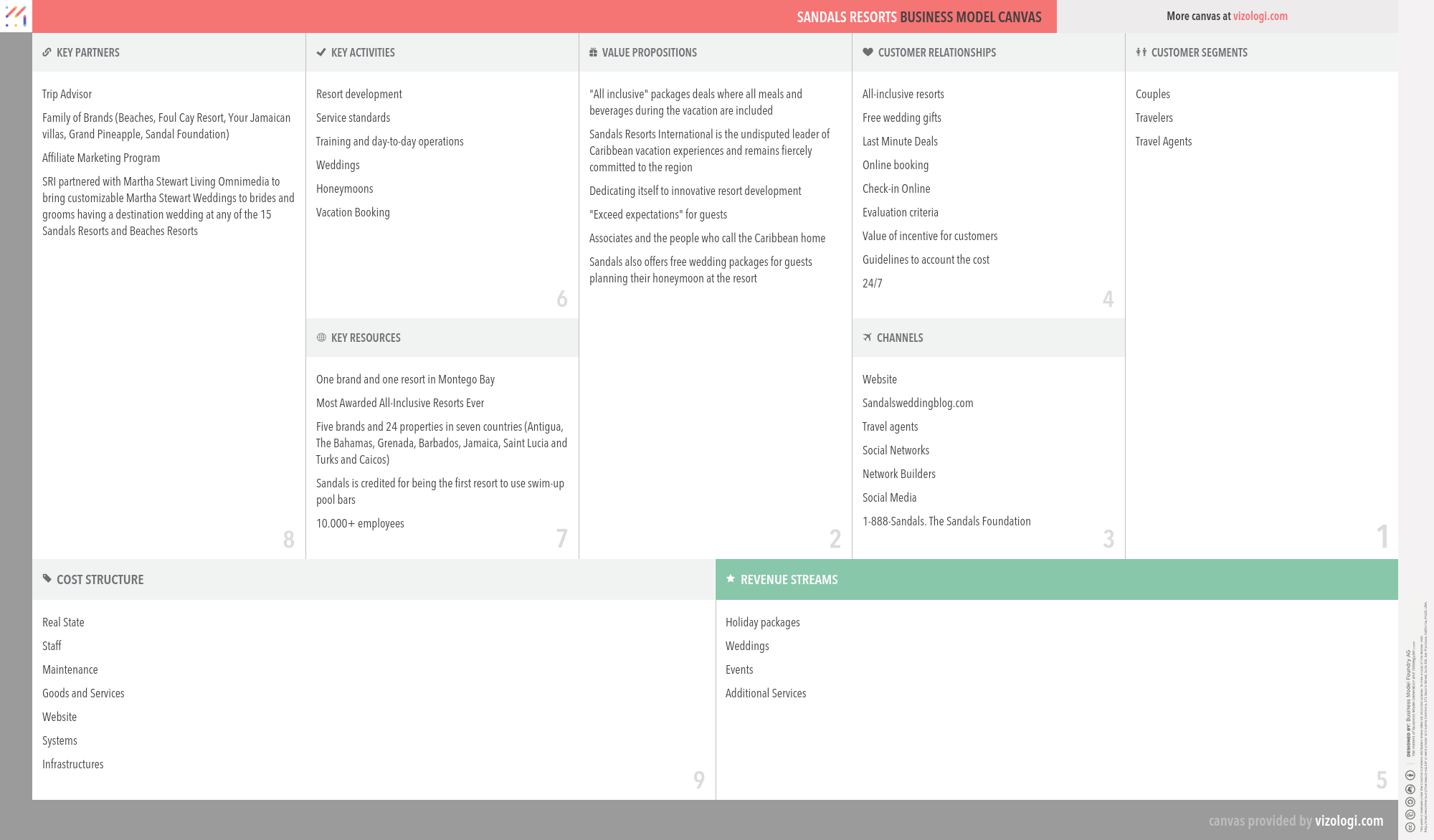Why Sandals Resorts's Business Model is so successful?
Get all the answers 
Sandals Resorts’s Company Overview
Sandals Resorts owns and operates about a dozen resorts in the Caribbean. The all-inclusive resorts, located in Antigua, the Bahamas, Jamaica, and St. Lucia, cater to couples and offer such upscale amenities as gourmet dining, spa services, and scuba diving and golf. The company additionally owns four Beaches resorts (the Turks & Caicos islands near Miami, and Boscobel and Negril in Jamaica) that cater to families. The company was founded in 1981 by Jamaican businessman Gordon "Butch" Stewart.
www.sandals.comSandals Resorts’s Customer Needs
Social impact:
Life changing: motivation
Emotional: rewards me, attractiveness, therapeutic value, fun/entertainment, provides access
Functional: Quality, variety, organizes, integrates, saves time, avoids hassles
Sandals Resorts’s Related Competitors
Sandals Resorts’s Business Operations
Affiliation:
Commissions are used in the affiliate revenue model example. Essentially, you resell goods from other merchants or businesses on your website or in your physical store. You are then compensated for referring new consumers to the company offering the goods or services. Affiliates often use a pay-per-sale or pay-per-display model. As a result, the business can access a more diversified prospective client base without extra active sales or marketing efforts. Affiliate marketing is a popular internet business strategy with significant potential for growth. When a client purchases via a referral link, the affiliate gets a portion of the transaction's cost.
Brands consortium:
A collection of brands that coexist under the auspices of a parent business. The businesses in this pattern develop, produce, and market equipment. Their strength is in copywriting. Occasionally used to refer to a short-term agreement in which many companies (from the same or other industrial sectors or countries) combine their financial and personnel resources to execute a significant project benefiting all group members.
Bundling:
Multiple products or services have been bundled together to enhance the value. Bundling is a marketing technique in which goods or services are bundled to be sold as a single entity. Bundling enables the purchasing of several goods and services from a single vendor. While the goods and services are often linked, they may also consist of different items that appeal to a particular market segment.
Credits:
A credit arrangement is when a consumer purchases items on credit (without paying cash) and spends the provider later. Typically, trade credit is extended for a certain number of days after the products are delivered. These credits may be deducted from one's tax liability.
Cross-selling:
Cross-selling is a business strategy in which additional services or goods are offered to the primary offering to attract new consumers and retain existing ones. Numerous businesses are increasingly diversifying their product lines with items that have little resemblance to their primary offerings. Walmart is one such example; they used to offer everything but food. They want their stores to function as one-stop shops. Thus, companies mitigate their reliance on particular items and increase overall sustainability by providing other goods and services.
Direct selling:
Direct selling refers to a situation in which a company's goods are immediately accessible from the manufacturer or service provider rather than via intermediate channels. The business avoids the retail margin and any extra expenses connected with the intermediaries in this manner. These savings may be passed on to the client, establishing a consistent sales experience. Furthermore, such intimate touch may help to strengthen client connections. Finally, direct selling benefits consumers by providing convenience and service, such as personal demonstrations and explanations of goods, home delivery, and substantial satisfaction guarantees.
Discount club:
The discount club concept is built on perpetual high-discount deals utilized as a continual marketing plan or a brief period (usually one day). This might be seen as a reduction in the face value of an invoice prepared in advance of its payments in the medium or long term.
Experience:
Disrupts by offering a better understanding that customers are willing to pay for. Experience companies that have progressed may begin charging for the value of the transformation that an experience provides. An experienced company charges for the feelings consumers get as a result of their interaction with it.
Flat rate:
This model is used to describe a pricing system that charges a single flat price for service regardless of its actual use or duration. A company may establish a responsible position in a market if customers get excellent pricing before performing the service. The consumer benefits from a straightforward cost structure, while the business benefits from a predictable income stream.
Remainder retail:
Remainder retail (affectionately referred to as daily deal, flash sale, or one deal a day) is an online business strategy in which a website sells a single product for a period of 24 to 36 hours. Customers may join deal-a-day websites as members and get online deals and invite through email or social media. The deal-of-the-day business model works by enabling merchants to advertise discounted services or goods directly to the deal company's consumers, with the deal company receiving a cut of the retailer's earnings. This enables merchants to foster brand loyalty and rapidly liquidate excess inventory.
Ultimate luxury:
This business approach is based on product distinctiveness and a high level of quality, emphasizing individuals with significant buying power. The expenditures required to create distinction are covered by the comparatively high prices charged, which often allow for very high profits.
Recommended companies based on your search:

